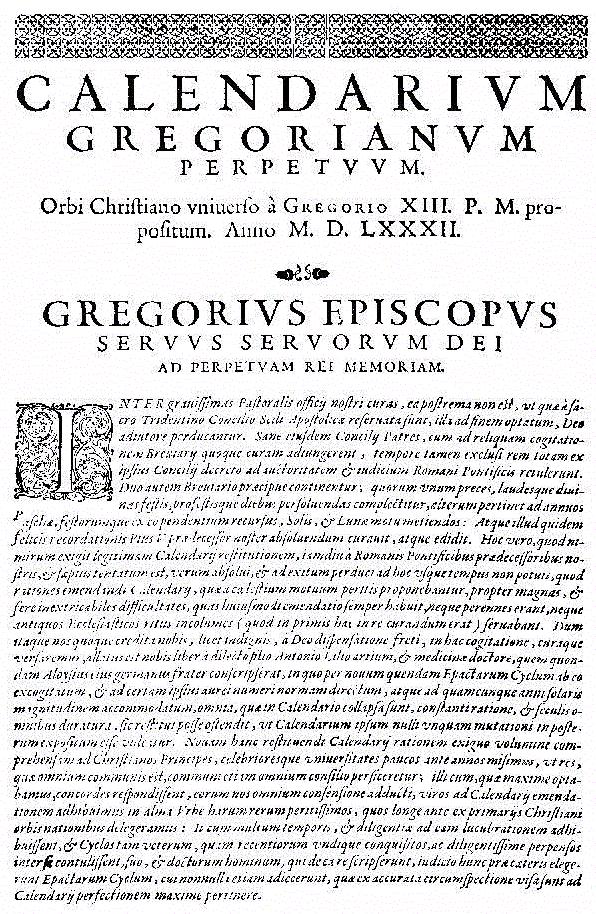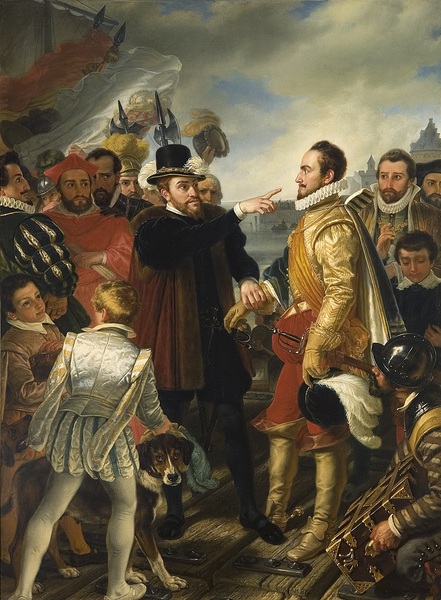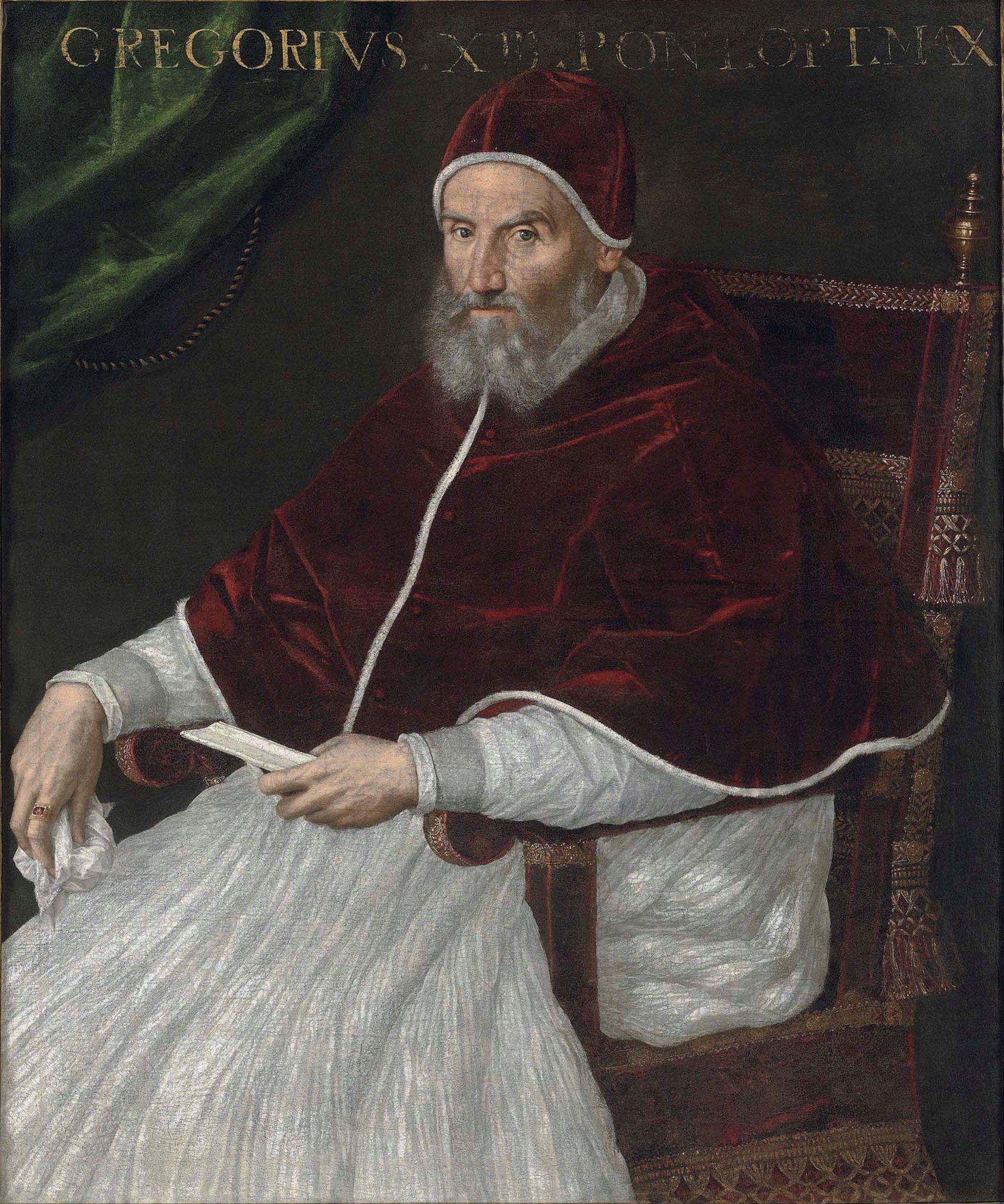|
1582
1582 ( MDLXXXII) was a common year starting on Monday in the Julian calendar, and a common year starting on Friday (link will display full calendar) of the Proleptic Gregorian calendar. This year saw the beginning of the Gregorian calendar switch, when the papal bull '' Inter gravissimas'' introduced the Gregorian calendar, adopted by Spain, Portugal, the Polish–Lithuanian Commonwealth and most of present-day Italy from the start. In these countries, the year continued as normal through Thursday, October 4; the next day became Friday, October 15, like a common year starting on Friday. France followed two months later, letting Sunday, December 9 be followed by Monday, December 20. Other countries continued using the Julian calendar, switching calendars in later years, and the complete conversion to the Gregorian calendar was not entirely done until 1923. Events January–March * January 2 – University of Würzburg is refounded. * January 15 – Russia cede ... [...More Info...] [...Related Items...] OR: [Wikipedia] [Google] [Baidu] |
Gregorian Calendar
The Gregorian calendar is the calendar used in most parts of the world. It went into effect in October 1582 following the papal bull issued by Pope Gregory XIII, which introduced it as a modification of, and replacement for, the Julian calendar. The principal change was to space leap years slightly differently to make the average calendar year 365.2425 days long rather than the Julian calendar's 365.25 days, thus more closely approximating the 365.2422-day tropical year, "tropical" or "solar" year that is determined by the Earth's revolution around the Sun. The rule for leap years is that every year divisible by four is a leap year, except for years that are divisible by 100, except in turn for years also divisible by 400. For example 1800 and 1900 were not leap years, but 2000 was. There were two reasons to establish the Gregorian calendar. First, the Julian calendar was based on the estimate that the average solar year is exactly 365.25 days long, an overestimate of a li ... [...More Info...] [...Related Items...] OR: [Wikipedia] [Google] [Baidu] |
Julian Calendar
The Julian calendar is a solar calendar of 365 days in every year with an additional leap day every fourth year (without exception). The Julian calendar is still used as a religious calendar in parts of the Eastern Orthodox Church and in parts of Oriental Orthodox Churches, Oriental Orthodoxy as well as by the Amazigh, Amazigh people (also known as the Berbers). The Julian calendar was proposed in 46 BC by (and takes its name from) Julius Caesar, as a reform of the earlier Roman calendar, which was largely a lunisolar calendar, lunisolar one. It took effect on , by his edict. Caesar's calendar became the predominant calendar in the Roman Empire and subsequently most of the Western world for more than 1,600 years, until 1582 when Pope Gregory XIII promulgated a revised calendar. Ancient Romans typically designated years by the names of ruling consuls; the ''Anno Domini'' system of numbering years was not devised until 525, and became widespread in Europe in the eighth cent ... [...More Info...] [...Related Items...] OR: [Wikipedia] [Google] [Baidu] |
François, Duke Of Anjou
''Monsieur'' François, Duke of Anjou and Alençon (; 18 March 1555 – 10 June 1584) was the youngest son of King Henry II of France and Catherine de' Medici. Early years He was scarred by smallpox at age eight, and his pitted face and slightly deformed spine did not suit his birth name of ''Hercule''. He changed his name to Francis in honour of his late brother Francis II of France when he was confirmed. The royal children were raised under the supervision of the governor and governess of the royal children, Claude d'Urfé and Françoise d'Humières, under the orders of Diane de Poitiers. In 1574, following the death of his brother Charles IX of France and the accession of his other brother Henry III of France, he became heir to the throne. In 1576 he was made Duke of Anjou, Touraine, and Berry. Alençon and the Huguenots During the night of 13 September 1575, Alençon fled from the French court after being alienated from his brother King Henry III as they had ha ... [...More Info...] [...Related Items...] OR: [Wikipedia] [Google] [Baidu] |
Inter Gravissimas
''Inter gravissimas'' (English: "Among the most serious...") was a papal bull issued by Pope Gregory XIII on 24 February 1582.''Inter Gravissimas'' Bill Spencer's translation of the ''Inter Gravissimas'', 1999, revised 2002, based on Rodolphe Audette's transcription of the text. Also includes Rodolphe Audette's translation into . The document, written in , reformed the . The reform has conventionally come to be regarded as a new calendar in its own right, called the |
University Of Würzburg
The Julius Maximilian University of Würzburg (also referred to as the University of Würzburg, in German ''Julius-Maximilians-Universität Würzburg'') is a public research university in Würzburg, Germany. Founded in 1402, it is one of the oldest institutions of higher learning in Germany. The university initially had a brief run and was closed in 1415. It was reopened in 1582 on the initiative of Julius Echter von Mespelbrunn. Today, the university is named for Julius Echter von Mespelbrunn and Maximilian Joseph. The University of Würzburg is part of the U15 group of research-intensive German universities. The university is also a member of the Coimbra Group. In the winter semester 2022/2023, 26,787 students were enrolled, of which 16,351 were women and 3,250 were first semester university students. The University is associated with 14 Nobel laureates. Name Its official name is Julius-Maximilians-Universität Würzburg (or "Julius-Maximilian University of Würzburg") b ... [...More Info...] [...Related Items...] OR: [Wikipedia] [Google] [Baidu] |
William The Silent
William the Silent or William the Taciturn (; 24 April 153310 July 1584), more commonly known in the Netherlands as William of Orange (), was the leader of the Dutch revolt against the Spanish Habsburg Netherlands, Habsburgs that set off the Eighty Years' War (1568–1648) and resulted in the formal independence of the Dutch Republic, United Provinces in 1648. Born into the House of Nassau, he became Prince of Orange in 1544 and is thereby the founder of the House of Orange-Nassau, Orange-Nassau branch and the ancestor of the monarchy of the Netherlands. In the Netherlands, he is also known as Father of the Nation, Father of the Fatherland (; ). A wealthy nobleman, William originally served the Habsburgs as a member of the court of Margaret of Parma, governor of the Spanish Netherlands. Unhappy with the centralisation of political power away from the local estates and with the Spanish persecution of Dutch Protestants, William joined the Dutch uprising and turned against his fo ... [...More Info...] [...Related Items...] OR: [Wikipedia] [Google] [Baidu] |
Proleptic Gregorian Calendar
The proleptic Gregorian calendar is produced by extending the Gregorian calendar backward to the dates preceding its official introduction in 1582. In nations that adopted the Gregorian calendar after its official and first introduction, dates occurring in the interim period of 15 October 1582 (the first date of use of Gregorian calendrical dates, being dated 5 October 1582 in the preceding Julian calendar) to the date on which the pertinent nation adopted the Gregorian calendar and abandoned the Julian calendar are sometimes 'Gregorianized' also. For example, the day of U.S. President George Washington's birth was originally dated 11 February 1731 (Old Style) because Great Britain, of which he was born a subject, used (until September 1752) the Julian calendar and dated the beginning of English years as 25 March instead of 1 January (e.g. 31 December 1700 was followed by 1 January 1700, and 24 March 1700 was followed by 25 March 1701). After Great Britain switched to the Gregorian ... [...More Info...] [...Related Items...] OR: [Wikipedia] [Google] [Baidu] |
Polish–Lithuanian Commonwealth
The Polish–Lithuanian Commonwealth, also referred to as Poland–Lithuania or the First Polish Republic (), was a federation, federative real union between the Crown of the Kingdom of Poland, Kingdom of Poland and the Grand Duchy of Lithuania, existing from 1569 to 1795. This state was among the largest, most populated countries of 16th- to 18th-century Europe. At its peak in the early 17th century, the Commonwealth spanned approximately and supported a multi-ethnic population of around 12 million as of 1618. The official languages of the Commonwealth were Polish language, Polish and Latin Language, Latin, with Catholic Church, Catholicism as the state religion. The Union of Lublin established the Commonwealth as a single entity on 1 July 1569. The two nations had previously been in a personal union since the Union of Krewo, Krewo Agreement of 1385 (Polish–Lithuanian union) and the subsequent marriage of Queen Jadwiga of Poland to Grand Duke Jogaila of Lithuania, who was cr ... [...More Info...] [...Related Items...] OR: [Wikipedia] [Google] [Baidu] |
Livonia
Livonia, known in earlier records as Livland, is a historical region on the eastern shores of the Baltic Sea. It is named after the Livonians, who lived on the shores of present-day Latvia. By the end of the 13th century, the name was extended to most of present-day Estonia and Latvia, which the Livonian Brothers of the Sword had conquered during the Livonian Crusade (1193–1290). Medieval Livonia, or ''Terra Mariana'', reached its greatest extent after the Saint George's Night Uprising (1343–1345), which forced Denmark to sell the Duchy of Estonia (1219–1346) , Duchy of Estonia (northern Estonia conquered by Denmark in the 13th century) to the State of the Teutonic Order in 1346. Livonia, as understood after the retreat of Denmark in 1346, bordered on the Gulf of Finland in the north, Lake Peipus and Russia to the east, and Lithuania to the south. As a consequence of the Livonian War (1558–1583), the territory of Livonia was reduced to the southern half of Estonia and ... [...More Info...] [...Related Items...] OR: [Wikipedia] [Google] [Baidu] |
Pope Gregory XIII
Pope Gregory XIII (, , born Ugo Boncompagni; 7 January 1502 – 10 April 1585) was head of the Catholic Church and ruler of the Papal States from 13 May 1572 to his death in April 1585. He is best known for commissioning and being the namesake for the Gregorian calendar, which remains the internationally accepted civil calendar to this day. Early biography Youth Ugo Boncompagni was born the son of Cristoforo Boncompagni (10 July 1470 – 1546) and Angela Marescalchi, and paternal grandson of Giacomo Boncompagni and Camilla Piattesi, in Bologna, where he studied law and graduated in 1530. He later taught jurisprudence for some years, and his students included notable figures such as Cardinals Alexander Farnese, Reginald Pole and Charles Borromeo. He had an illegitimate son after an affair with Maddalena Fulchini, Giacomo Boncompagni, but before he took holy orders, making him the last Pope to have left issue. Career before papacy At the age of 36 he was summoned to Rome ... [...More Info...] [...Related Items...] OR: [Wikipedia] [Google] [Baidu] |
Edward Kelley
Sir Edward Kelley or Kelly, also known as Edward Talbot (; 1 August 1555 – 1597/8), was an English Renaissance occultist and scryer. He is known for working with John Dee in his magical investigations. Besides the professed ability to see spirits or angels in a "shew-stone" or mirror, which John Dee so valued, Kelley also said that he possessed the secret of transmuting base metals into gold, a goal of alchemy, as well as the philosopher's stone itself. Legends began to surround Kelley shortly after his death. His flamboyant biography, his relationships with Queen Elizabeth I's royal magus Sir John Dee and Emperor Rudolf II, and his repute of having great alchemical skill and the ability to communicate with angels have all led to his relative notoriety among historians. Biography Birth and early career Much of Kelley's early life is obscure. He said he was descended from the family of Ui Maine in Ireland. He was born at Worcester on 1 August 1555, at 4 P.M. according ... [...More Info...] [...Related Items...] OR: [Wikipedia] [Google] [Baidu] |






